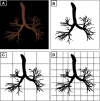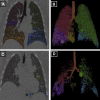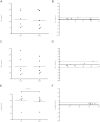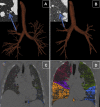Quantitative computed tomography-derived clusters: redefining airway remodeling in asthmatic patients
- PMID: 24238646
- PMCID: PMC3969578
- DOI: 10.1016/j.jaci.2013.09.039
Quantitative computed tomography-derived clusters: redefining airway remodeling in asthmatic patients
Abstract
Background: Asthma heterogeneity is multidimensional and requires additional tools to unravel its complexity. Computed tomography (CT)-assessed proximal airway remodeling and air trapping in asthmatic patients might provide new insights into underlying disease mechanisms.
Objectives: The aim of this study was to explore novel, quantitative, CT-determined asthma phenotypes.
Methods: Sixty-five asthmatic patients and 30 healthy subjects underwent detailed clinical, physiologic characterization and quantitative CT analysis. Factor and cluster analysis techniques were used to determine 3 novel, quantitative, CT-based asthma phenotypes.
Results: Patients with severe and mild-to-moderate asthma demonstrated smaller mean right upper lobe apical segmental bronchus (RB1) lumen volume (LV) in comparison with healthy control subjects (272.3 mm(3) [SD, 112.6 mm(3)], 259.0 mm(3) [SD, 53.3 mm(3)], 366.4 mm(3) [SD, 195.3 mm(3)], respectively; P = .007) but no difference in RB1 wall volume (WV). Air trapping measured based on mean lung density expiratory/inspiratory ratio was greater in patients with severe and mild-to-moderate asthma compared with that seen in healthy control subjects (0.861 [SD, 0.05)], 0.866 [SD, 0.07], and 0.830 [SD, 0.06], respectively; P = .04). The fractal dimension of the segmented airway tree was less in asthmatic patients compared with that seen in control subjects (P = .007). Three novel, quantitative, CT-based asthma clusters were identified, all of which demonstrated air trapping. Cluster 1 demonstrates increased RB1 WV and RB1 LV but decreased RB1 percentage WV. On the contrary, cluster 3 subjects have the smallest RB1 WV and LV values but the highest RB1 percentage WV values. There is a lack of proximal airway remodeling in cluster 2 subjects.
Conclusions: Quantitative CT analysis provides a new perspective in asthma phenotyping, which might prove useful in patient selection for novel therapies.
Keywords: Asthma; CT; airway remodeling; cluster analysis; distal airway; fractal analysis; phenotypes; quantitative imaging.
Copyright © 2013 The Authors. Published by Mosby, Inc. All rights reserved.
Figures









Comment in
-
Can computed tomography help us identify asthmatic phenotypes?J Allergy Clin Immunol. 2014 Mar;133(3):739-40. doi: 10.1016/j.jaci.2013.12.1036. Epub 2014 Jan 25. J Allergy Clin Immunol. 2014. PMID: 24472625 No abstract available.
-
Reply: To PMID 24238646.J Allergy Clin Immunol. 2014 Jun;133(6):1777-8. doi: 10.1016/j.jaci.2014.01.043. Epub 2014 May 1. J Allergy Clin Immunol. 2014. PMID: 24792873 No abstract available.
-
Bronchi wall and lumen volumes to assess airway remodeling in asthma by using CT: an innovative method?J Allergy Clin Immunol. 2014 Jun;133(6):1777. doi: 10.1016/j.jaci.2014.01.044. Epub 2014 May 1. J Allergy Clin Immunol. 2014. PMID: 24792874 No abstract available.
References
-
- Bousquet J., Mantzouranis E., Cruz A.A., Ait-Khaled N., Baena-Cagnani C.E., Bleecker E.R. Uniform definition of asthma severity, control, and exacerbations: document presented for the World Health Organization Consultation on Severe Asthma. J Allergy Clin Immunol. 2010;126:926–938. - PubMed
-
- Taylor D.R., Bateman E.D., Boulet L.P., Boushey H.A., Busse W.W., Casale T.B. A new perspective on concepts of asthma severity and control. Eur Respir J. 2008;32:545–554. - PubMed
-
- Haldar P., Pavord I.D. Noneosinophilic asthma: a distinct clinical and pathologic phenotype. J Allergy Clin Immunol. 2007;119:1043–1052. - PubMed
-
- Anderson G.P. Endotyping asthma: new insights into key pathogenic mechanisms in a complex, heterogeneous disease. Lancet. 2008;372:1107–1119. - PubMed
Publication types
MeSH terms
Grants and funding
LinkOut - more resources
Full Text Sources
Other Literature Sources
Medical
Miscellaneous

